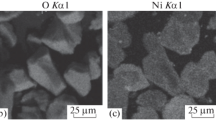Summary
-
1.
Poisoning by means of sulfur containing compounds of dehydrogenating catalysts consisting og different concentrations of platinum on various carriers has been studied, The effect of all the poisons is equal to that an equivalent amount of hydrogen sulfide.
-
2.
The structure of the poison molecule does not affect its action, suggesting that they are all decomposed at the catalysts surface at about the same rate, with production of hydrogen sulfide.
-
3.
The amount of organically combined sulfur required to poison the catalysts is proportional to the amount of platinum contained therein.
-
4.
The amount of sulfur required to lower the activity of catalysts by 70–80% is about 6–7% of the weight of platinum present on the carrier.
-
5.
The regenerability of platinum catalysts poisoned with one and the same substances varies according to the nature of the carriers.
-
6.
It has been shown experimentally that the activation energy of the reaction of dehydrogenation of cyclhexane is the same for poisoned and unpoisoned catalyst. The value ofo the pre-exponential terms of the Arrhenius equation is ten times smaller for poisoned than for fresh catalysts. These data, together with crystal lattice data, indicate that poisoning of platinum catalysts is due to occlusion of active centers.
Similar content being viewed by others
Literature cited
M. Baccaredda, Handbuch der Katalyse, Bd. VI, Heterogene Katalyse, III. Vergiftung der Kontakte, Wien, 1943, p. 235–296.
S. Berkman, D. Morrell, and G. Egloff, Catalysis in inorganic and organic chemistry, Vol. 1, p. 382. Moscow Leningrad, 1949.
V. P. Kamzolkin and V. D. Livshits, J. Applied Chem. 14, 1225 (1937); L. E. Adadurov and M. A. Gushinskaya, J. Appl. Chem. 5, 722 (1932).
N. D. Zelinsky, Tech.-Economic J., 5, 854 (1925); Selected works, Vol. 2, p. 7. Moscow-Leningrad, 1941.
N. D. Zelinsky and M. B. Turova-Polyak. Ber., 59, 156 (1926).
N. L. Shopkin, S. S. Novikov, and E. D. Tulupova, Bull. Acad. Sci. USSSR Div. Chem. Sci. No. 1, 89 (1947).
A. M. Rubinshtein, Kh. M. Minachev, and N. L. Shuskin, Proc. Acad. Sci. U.S.S.R. 67, 287 (1949).
L. Kh. Freidlin and N. I. Ziminova, Proc. Acad. Sci. 76, 551 (1951); Bull. Acad. Sci. USSR, Div. Chem. Sci. No. 6, 659 (1950); Proc. Acad. Sci. U.S.S.R. 74, 955 (1950).
A. M. Eubinshtein and N. A. Pribytkova, Proc. Acad. Sci. U.S.S.R., 61 285 (1948); A. M. Rubinshtein, Problems of kinetics and catalysis, No. 6, p. 127. Acad. Sci. U.S.S>R. Press, Moscoe, 1949.
N. D. Zelinsky, I. A. Musaev, and G. D. Galpern, Bull. Acad. Sci. USSR, Div. Chem. Sci. No. 2, 467 (1937); N. D. Zelinsky. Selected works, Vol. 1, p. 600. Moscow-Leningrad.
N. D. Zelinsky and E. M. Shakhnazarova, Bull. Acad. Sci. USSR, Div. Chem. Sci. No. 3–4, 571 (1936).
Author information
Authors and Affiliations
Rights and permissions
About this article
Cite this article
Minachev, K.M., Shuikin, N.I. & Rozhdestivenskaya, I.D. Poisoning of platinum catalysts with a low content of active metal on a carrier, under conditions of dehydrogenation catalysis. Russ Chem Bull 1, 567–575 (1952). https://doi.org/10.1007/BF01164919
Received:
Issue Date:
DOI: https://doi.org/10.1007/BF01164919



